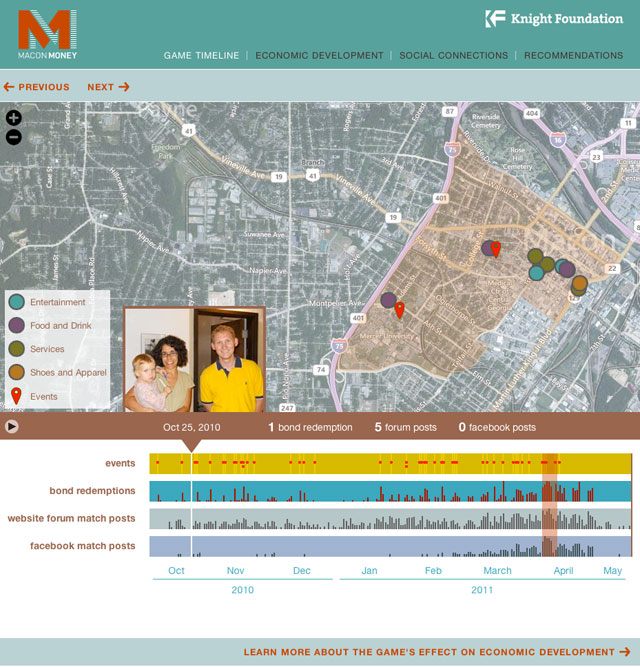
Seven lessons learned about social impact games
The prevalence of games in people’s lives is undeniable. Nearly three-quarters of all American families play computer and video games. Increasingly, businesses, nonprofits, funders and governments are tapping into this trend, experimenting with games to unlock existing social challenges. Yet, what are games good for and when are they most effective?
Last month, we completed an in-depth evaluation of two-real world social impact games Knight funded to bring individuals together to address local challenges: Macon Money, an alternative form of local currency to connect residents to each other and to attract and expose people to local business in Macon, Ga.; and Battlestorm, a youth-based game to improve hurricane preparation awareness and habits in Biloxi, Miss.
We’re excited to share the results of these two experiments today at the 9th Annual Games for Change Festival! While a lot has been written about the impact of digital games on learning, less attention has been paid to the effects of real-world games – i.e., games that are played out in the physical world. We hope the insights gathered will encourage funders, researchers and gamers to explore the potential of these games with us and help move the field forward.
In addition to the main study, we’ve created an interactive data visualization synthesizing the Macon Money findings and an infographic poster on Battlestorm.
Here are seven lessons about the effectiveness of the two real-world games and how games can be leveraged for social impact in communities.
1. Making Exploration Safe – Games are powerful liberating structures that allow people to test new patterns of behavior in a playful and secure environment. In Macon Money, residents took advantage of their free currency to experiment with new spending habits: 46% of players surveyed spent their bills at a local business they’d never frequented before, and 92% of those players report returning to those businesses after the game.
2. Play as Catharsis – Games can provide a unique entry point for role playing and dealing with difficult issues. In Battlestorm, most of the families of children that played the game had experienced the trauma of Hurricane Katrina. The game triggered conversations about hurricanes that were cathartic and helped families process their emotional experiences.
3. Building Weak Ties that Bind – Games can engineer serendipitous interactions between people that build social capital in communities. In Macon, two out of three matches by players were with people previously unknown to them and, of these, more than three quarters were with people whom they reported as unlikely to meet based on their differences. 20 percent of these matches led to further personal contact – including one marriage! Interestingly, 71 percent of players surveyed said they’d recognize their matches and say “hi” if they saw them again in the street. Why does this matter? Because researchers have long showed that people feel safer and more connected when they recognize friendly faces where they live.
4. Linking Strategic Play to Knowledge Gains – Game elements built around strategic play are likely to produce the most measurable learning outcomes. In Battlestorm, surveys indicated that players did not significantly improve their understanding of hurricanes or their interest in learning about hurricane prep. Yet, there was one intriguing exception: kids were able to better identify items that go into a hurricane prep kit, such as a flashlight, as these were elements used as ‘power tokens’ in the game to boost a team’s advantage. In short, concepts that were most directly tied to game strategy produced the greatest knowledge gains.
5. Turning Gamers into Superconductors – Games can turn players into successful conduits that spread the message and social content of a game to their families, friends and communities. The majority of children that played Battlestorm (68 per cent) went on to spark conversations with their parents and friends about hurricane preparedness and having a family evacuation plan. A third of the parents reported learning something new from their child who played the game.
6. Building the Future with the Bricks of the Past – Infusing the novelty of real-world games with a community’s historical identity and symbols encourages greater ownership of the experience and adoption of the technology. In Macon, using the city’s historical pictures and icons on the Macon Money bills gave the game a distinct local brand that residents took great pride in playing.
7. Celebrating When You Get Hacked – Player activities that improvise on a game’s underlying structure should be embraced rather than discouraged. In Macon Money, players used Facebook to post images of their half-bond to find their match, and local business started setting up their own ‘find your match’ events to help drive traffic to their stores. A sign of success is when players layer additional activities onto a game that you never expected.
I’d like to thank our wonderful evaluation partners, Cause Communications and Network Impact, as well as our advisory team – Tracy Fullerton, Jim Gee, Beth Kolko and Ben Stokes – for all their guidance and help with the study!
By Mayur Patel, vice president/strategy and assessment at Knight Foundation
Below are Patel’s slides from his presentation at the Games for Change festival
Recent Content
-
Communitiesarticle ·
-
Communitiesarticle ·
-
Communitiesarticle ·


